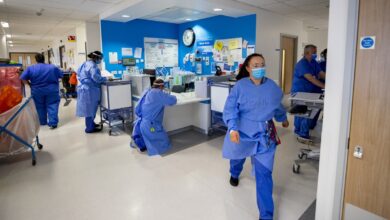Inside Britain’s £1.1bn Covid lab that no one knows what to do with

It was hailed as a cutting-edge laboratory that would play a key role in response to Covid-19 and future epidemics, carrying out 300,000 tests a day.
Announcing the project in November 2020, then-health secretary Matt Hancock said the project “confirms the UK as a world leader in diagnostics”.
But less than 18 months later, the Rosalind Franklin Laboratory – named in honour of the renowned British scientist – has been plagued by failure while costing almost twice as much as its initial £588m budget, The Independent understands.
Instead of being at the forefront of the fight against Covid, the project opened six months late, facing a string of issues with equipment, staff and construction, with barely 20 per cent of its touted capacity being reached.
Now, as the government winds down its “lighthouse” testing labs as part of the plan to “live with Covid”, leaving the Leamington Spa facility as the last lab standing, there are questions about the future of the site – and whether it would be able to cope with the nation’s testing needs alone if another deadly wave of Covid were to emerge.
The project was announced as a flagship for the new UK Health Security Agency (UKHSA), which succeeded Public Health England as the body responsible for protecting the public from infectious diseases and oversees Covid testing in Britain.
The 220,000 square foot site, lauded as the largest testing facility of its kind in Europe, had been due to open the first of its processing lines in January 2021, the peak of the second wave of Covid-19. By June that year, nine out of 12 lines were to be functional.
However, it was not until 13 July that the laboratory was formally opened, with just a single line running. It was acknowledged that four of the lines would never be built, despite officials placing and receiving orders for testing equipment worth millions, sources involved in setting up the lab told The Independent.
“The Department for Health has said that was the plan all along. That absolutely was not the plan,” said an ex-senior scientist.
Insiders say construction delays also played a role, while attempts to avoid certifying equipment to speed up the process were stopped at the 11th hour, contributing to “massive pushbacks”. The UKHSA has said these claims are untrue.
Insiders believe these delays could have been avoided had the RFL recruited scientists and clinicians with the relevant experience from the beginning of the project, instead of relying on private consultants whose knowledge of working in the NHS was “almost non-existent”.
According to emails seen by The Independent, 31 lab support technicians were informed last summer – days before they were due to start work – that they would be paid to stay at home indefinitely due to delays, at a cost of tens of thousands of pounds to the taxpayer. A further 700 staff were on retainer last summer but had yet to begin work.
Staff “are all on short-term contracts,” said one senior scientist overseeing the UK’s Lighthouse Lab network. “That creates problems in running labs because if you’re on a short-term contract, and the longer-term job comes up, you’re naturally going to move on.”
Its total budget was set at £588m, according to internal figures from June 2021. But by May that year, £500m had already been spent with costs “spiralling”, the former senior scientist said.
By November, the site was hundreds of millions of pounds over budget, according to another person familiar with the project’s finances. By February, estimates put the project’s cost at £1.1bn, according to a Treasury source, who said costs were now out of hand. The UKHSA has said it does not recognise these numbers.
In reality, government officials do not have a clear picture of how much has been spent on the project, according to the Treasury insider and a consultant involved in reviewing the lab’s future.
Prior to the opening of the site, when it became apparent that the RFL would not be built to its original intended size, procurement teams were pressured to break contracts with suppliers and “write off orders” for equipment worth hundreds of thousands of pounds, insiders say.
“We were told under no uncertain terms to never provide things like long-term equipment delivery schedules because that could be considered a promise to the supplier to honour the original arrangement in a court of law,” said the former senior scientist, who helped oversee procurement for the lab.
The health secretary, Sajid Javid, during a visit to the Rosalind Franklin laboratory last year





